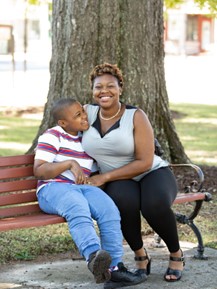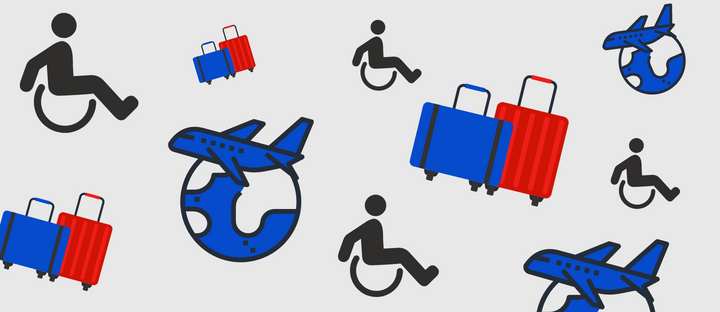Whether you’re planning a trip to New York City to participate in the KOALA Study at Columbia University or you’re going on vacation, traveling can be a daunting process. In this guest blog post, Charisma Freeman—mother to KIF1A superhero Cam, author, care coach, and more—shares her tips on traveling with disabilities.

So you’re ready to book a trip (or you already booked it) and you need to prepare for your flight with special needs or a disability. Well, I’m going to walk you through the steps to make things easier for you and your family.
Charisma Freeman, AKA Cam’s Mom – with Charisma Cares
Booking
- When traveling with someone using any type of medical device(s) be sure to notate it when you’re purchasing your ticket. They will email or call you with special instructions. Regardless, it’s always good to call the airline within a week of your flight to confirm the details.
- Alert the airline of any allergies when booking. They will make flights peanuts-free if necessary (for those airlines that still serve peanuts).
- Know when to check-in. Some airlines do not pre-book seats anymore unless it’s international or you pay for it. Some will open the seat bookings 24 hours before the flight time online and allow you to choose the seats. Please know that those good seats are gone in the first hour. So be ready.
- Know your bag fees. You are typically allotted one personal item and one carry-on per person. Southwest allows 2 free checked bags AND most international flights allow at least 1 free checked bag. Know the policies and the fees.
- Weigh your bags before leaving home. All airlines have baggage weight limits. Most will give you a 3lb grace but there’s nothing worse than being at 55 pounds instead of 50 pounds pulling shoes out at the checkout counter. You can purchase a luggage weight scale online or at the store.
Arrival
- When you arrive to check-in, DO let the ticket counter know you need assistance with a wheelchair. It can take up to 30 minutes for them to get a helper but they will escort you to the gate. Since Covid, we’ve been seeing longer wait times. So arrive early. Suggested times are 2 hours domestic and 3 hours international. I’d give an extra 30 minutes to 1 hour if you need assistance.
- When it’s time to go through security, you will go to the disability-friendly line. In the United States, this is typically the same line as TSA PreCheck (https://www.tsa.gov/precheck).
- If you are wheelchair-dependent but can walk short distances, you have a choice to walk through security or have them wand you inside your chair. Parents can be present to wand their children but must go through the security checkpoint first.
- You will be able to bring all medications. I recommend putting them all in a gallon Ziplock bag in the same CARRY-ON BAG, if possible to keep things simple.
- In the United States, TSA Cares is useful if you need assistance getting through security and have special needs or a disability. You contact them or complete a form online 72 hours prior to your flight and they will be there to help you when you arrive. https://www.tsa.gov/travel/passenger-support.
- So you’ve made it to security and you’re at your gate. Let the flight attendant know you or someone you’re escorting has a disability and will need early boarding. They should already know, but I found that by letting them know they will look for us when we’re ready to board. It also seems to help them prepare for any assistance you may need.
- Now, it’s time to start boarding and you will be called first. Ask for assistance, if needed. Wheelchairs cannot fit on the plane, but they have special aisle wheelchairs to get you to your seat. For example, my son uses crutches for short distances, but it isn’t very easy to walk down the aisle with crutches. So, we use the aisle wheelchair. Since we already told the flight attendant early on about our needs, they already have it out and ready to roll.
Ready for Lift-Off
- Hopefully, you didn’t forget gum, hard candy, or lollipops🍭. The change in elevations can be murderous to the ears. Some people have had good luck with noise-reducing headphones as well. If you have a sinus infection or earache prior to the flight, PLEASE see your doctor, it will only get worse with the change in atmospheric pressure.
- Be sure to carry books, coloring, games, and tablets WITH headphones to keep the kids AND adults happy during the flight. Download everything to your tablet that you would need on the flight before you board. Some flights will have videos and games on the seat, some will have Wi-Fi, or you may have free Wi-Fi through your cell carrier (be sure to check). But better safe than sorry.
Arrival
- If you checked anything at the gate, you’re in no rush to get off the plane. It’ll take 15-30 minutes to get your items back to you. So just watch the crowd scramble for a little while before you join in. You will meet your wheelchair right outside the plane where you dropped it off.
- Make sure you have everything you brought on your flight and check your equipment before you leave the gate.
- If you requested assistance, a TSA or an airline employee will be there to transport you from the gate to the exit.
Now you’re off to your next adventure!!! Do you have a travel tip to share? Leave a comment on this post!
I’m Charisma, a single mom, and my son Cam has KIF1A, We are currently traveling the world while we still can. Although it isn’t easy, it’s my primary purpose in life at this time: To Give Him the World. I would love for you to follow us on YouTube at Charisma Cares. We show our trips and travel adventures being a mom and son duo with a disability!!! If you have any questions feel free to send me an email at charismascare@hotmail.com or connect with me on FB or IG at Charisma Cares. I’m happy to help my KIF1A family!


These tips are so helpful! Thank you, Charisma!